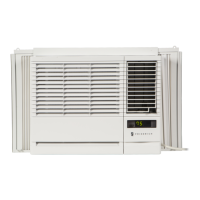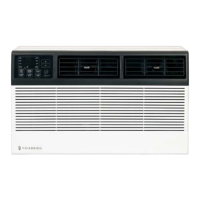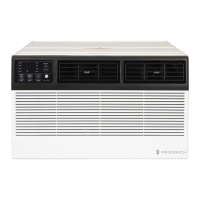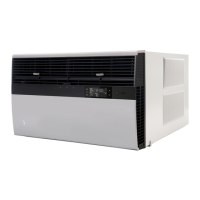Page 23
This valve is temperature sensitive and will open when
the outside temperature reaches 40°F. The valve will close
gradually as the temperature rises above 40°F to fully
close at 60°F.
Figure 16: DRAIN PAN VALVE
REVERSING VALVE
(Heat Pump Model Only)
A reversing valve is used to change the refrigerant flow
within the system to permit heating or cooling (see Figure
17.)
The reversing valve consists of a main valve body which
houses the slide and piston, plus a pivot valve which is
activated by a solenoid.
There are three tubes connected to one side of the main
valve body and one tube on the opposite side. The single
tube is connected to the compressor discharge line. The
center tube on the opposite side is the common suction
line to the compressor. The outside tubes are connected
to the indoor and outdoor coils.
Figure 17: REVERSING VALVE
The pilot valve is responsible for directing the refrigerant
flow to the indoor or outdoor coil. There are three small
tubes connected to the pilot valve body. The center pilot
tube is the common pilot tube and is connected to the
center suction line. The outside tubes are connected to
each end of the main valve body. The pilot valve consists
of a needle valve and spring. When the solenoid is de-
energized, the spring tension closes one pilot port while
the others remain open. When the solenoid is energized,
the opposite end is closed. The piston in the main valve
is pressure operated and will always travel in the direction
of the open pilot tube port which provides a path to the
center tube. Pressure which will increase in the opposite
end of the valve will escape through a bleed port located
in each piston. When de-energized, the valve will be in
the cooling position.
TESTING REVERSING VALVE
Occasionally, the reversing valve may stick in the heating
or cooling position or in the mid-position.
When stuck in the mid-position, part of the discharge
gas from the compressor is directed back to the suction
side, resulting in excessively high suction pressure.
Check the operation of the valve by starting the system
and switching the operation from "cooling" to "heating"
and then back to "cooling". Do not hammer on the valve.
If valve fails to change its position, test the voltage to
the valve coil while the system is in the heating cycle. If
voltage to coil is satisfactory, replace reversing valve.
Should the valve fail to shift from cooling to heating,
block the air flow through the indoor coil and allow
discharge pressure to build in the system. Then switch
the system from cooling to heating.
If valve is stuck in the heating position, block the air
flow through the indoor coil and allow discharge pressure
to build in the system. Then switch the system from
heating to cooling.
Should the valve fail to shift in either position after
increasing the discharge pressure, replace the valve.
NOTE: When brazing a reverse valve into the system,
it is of extreme importance that the temperature
of the valve does not exceed 250°F at any time.
Wrap the reversing valve with a large rag
saturated with water. "Re-wet" the rag and
thoroughly cool the valve after brazing operation
of the four joints involved.
The wet rag around the reversing valve will
Figure 17: REVERSING VALVE
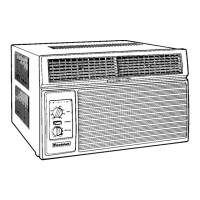
